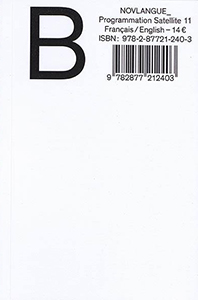In this age of speech-as-spectacle, horizontality of information, and language as screen, does the voice of the strongest always prevail? Newspeak, the thread that runs through George Orwell's dystopian novel
Nineteen Eighty-Four, was a language developed by the government to limit freedom of thought and personal identity. It was based on simplification, neologism and affect, and advocated non-alienation from facts and diminishing the likelihood of critical thought. Its vocabulary was divided into three groups. The B vocabulary, used for political discourse, is the breeding ground for the project proposed by Damir Očko.
The exhibition revolves around the film
Dicta II (the plural of “dictum”, coming from the Latin, meaning an undisputed truth). Following
Dicta I, based on the autobiographical writings of Bertolt Brecht's
Telling the Truth: 5 Difficulties (1934), written when the latter fled the German regime,
Dicta II is built around a series of safewords. Influenced by
Dadaism and
conceptual art, the film takes the form of a
collage and regroups an ensemble of inaudible and contradictory statements, as obscure as the images. The film evokes epic theatre and Brechtian distancing which awakens the viewer's political consciousness.
Published on the occasion of the eponymous exhibition at Jeu de Paume, Paris, from February 6 to May 20, 2018, at CAPC musée d'art contemporain de Bordeaux from February 13 to May 6, 2018, and at the Amparo Museum in Puebla, Mexico, from November 7, 2018, to January 19, 2019.
The Jeu de Paume's Satellite program devoted to contemporary art was initiated in 2007. In 2017, the Jeu de Paume and the CAPC musée d'art contemporain de Bordeaux are jointly organizing the tenth in this series of exhibitions, which from the outset have been entrusted to curators of international renown (Fabienne Fulchéri, María Inés Rodríguez, Elena Filipovic,
Raimundas Malašauskas, Filipa Oliveira,
Mathieu Copeland, Nataša Petrešin-Bachelez, Erin Gleeson, and Heidi Ballet, Osei Bonsu).
Curated by independent exhibition curator and art critic
Agnès Violeau, “NEWSPEAK_”, the 11th edition of the Satellite Programme, consists of work by artists Damir Očko,
Daphné Le Sergent and
Alejandro Cesarco, engaging public discourse as a strategy towards individuation. The three exhibitions can be added to the growing critical analysis of today's diminished thinking, offering a hypothetical response to the limits of a formatted, segmented and pared-down language.
In the era of the
digital revolution and the proliferation of technology, where even public speech, relayed by the
media, makes use of social and IT networks as a new agora, the question of a reduced, formatted, and simplified
language has once again been raised. This geopolitical transformation is reminiscent of a linguistic landscape imagined in a work of
literature as early as 1949. Newspeak is the official language of Oceania, a fictional state invented by George Orwell in his dystopian novel
Nineteen Eighty-Four. Wikipedia defines Newspeak as ‘a controlled language, of restricted grammar and limited vocabulary, a linguistic design meant to limit […] freedom of thought,'3 allowing people to be easily manipulated by the mass media, and television in particular.
This lexical and syntactical simplification of language makes critical thought difficult, if not impossible. The minimalistic Newspeak model of language functions therefore as a language-screen, constructed on affect, ideology, rhetoric and absolute precision. Language becomes the obstacle that lies between truth and misrepresentation.
Pointing towards an ever shorter distance between the information given and its interpretation, but also the new possibility of navigating between words and signs, “NEWSPEAK_” attempts to create a cosmogony of language, a laboratory of thought, and a form of resistance through the field of language and exhibition.
The work of Damir Očko (born 1977 in Zagreb, where he lives and works) is an invitation to explore the intricacies of
language and the way in which the neurophysiological system generates it so poetically. His various works fall within a corpus of ideas where the elements respond to each other, vacillating between desire and deprivation, reality and fiction.
Damir Očko has had numerous solo exhibitions, notably at the Dazibao in Montreal (2016), the Croatian pavilion at the 56th Venice Biennale (2015), the Künstlerhaus Halle für Kunst & Medien in Graz and the Temple Bar Gallery & Studios in Dublin (2014), the
Palais de Tokyo in Paris (2012), the Kunsthalle Düsseldorf (2011), the Kunstverein Leipzig (2010) and the Museum of Contemporary Art in Zagreb (2005). He has also taken part in group exhibitions at the Austrian Cultural Forum in New York (2016), the Württembergischer Kunstverein in Stuttgart (2015), the Kunsthalle Wien, the Collection Lambert in Avignon,
Le Plateau in Paris (2014) and the MUDAM, Luxembourg (2013).

